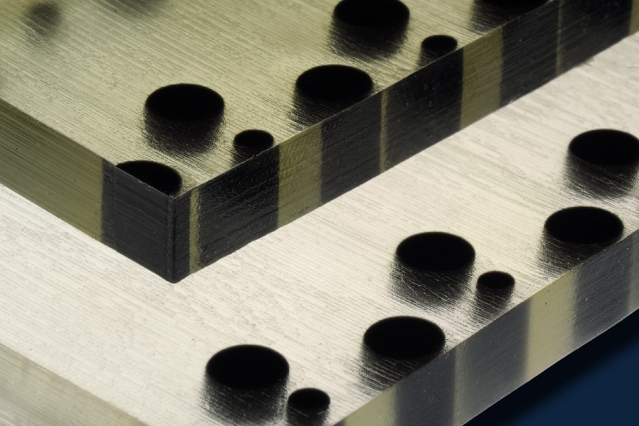Jun 11 2015
Researchers at MIT have developed an innovative 3D printing method to produce soft materials having surface textures that are controllable by squeezing.
 Polymer material produced by a 3-D printer includes soft, flexible material (clear or lighter tone) with particles of hard material (black) embedded, in predetermined arrangements. When the material is compressed, its surface become bumpy in a pattern determined by the hard particles. Photo: Felice Frankel
Polymer material produced by a 3-D printer includes soft, flexible material (clear or lighter tone) with particles of hard material (black) embedded, in predetermined arrangements. When the material is compressed, its surface become bumpy in a pattern determined by the hard particles. Photo: Felice Frankel
Different types of textures, including bumpy, ridged, complex or smooth textures could be produced. The findings of this study could lead to development of a new class of materials that possess surface properties that are controllable and reversible, dynamically.
The team had used a material that was made up of two different polymers that had different stiffness. They embedded more rigid particles in the polymer that was more flexible. When this soft material was squeezed, its surface changed into a pattern that was dependent on the shape of the more rigid embedded particles, as well as the distance between each of these particles. When the squeezing was stopped and the material was released, it regained its original form.
Mark Guttag, an MIT graduate student, and Mary Boyce, presently dean of engineering at Columbia University, and who was a former professor of mechanical engineering at MIT, had co-authored this study.
Depending on the arrangement of the particles, using the same amount of compression, you can get different surface topographies, including ridges and bumps, along the surface.
Mark Guttag , MIT
Simple patterns of creases or bumps that are repetitive in nature can be produced by this system. This feature could help modify an object’s reflectivity or aerodynamic resistance. Specific arrangement of the hard particle distribution could help produce very complex surface textures. In biological or chemical detectors, liquid movement could be controlled by creating microfluidic channels that could be produced by specific surface textures.
A device with such a design would have a tilted but smooth surface, which would allow even fluid flow over its surface. Additionally, depressions and raised sections could be induced when desired, which would separate the liquid flow.
Surface textures play an important role in numerous applications. They are used to control turbulence and motion of liquids, control organism buildup on surfaces, make surfaces to attract water or repel water, and for camouflaging applications.
Fixed patterns that do not have a varying surface can be produced in numerous methods. However, nonuniform textures that are changeable provide additional benefits for camouflaging and drag reduction applications.
There are no previous techniques that provide comparable flexibility for creating dynamically and locally tunable and reversible surface changes.
Mark Guttag , MIT
Because the system is “all geometry driven,” Guttag says — based on the shapes and spacing of materials with different degrees of flexibility — “it could be scaled to all different sizes, and the same principles should work.”
The researchers controlled the texture using physical pressure in this study. Similarly, modifying humidity or temperature, or applying an electrical charge, or other such external stimuli could be used for modifying the materials.
Asymmetrical surface textures could be created by using elongated embedded particles. Surfaces that are slippery in one direction, but demonstrate high friction in the other direction, could be created using this method. This would help control the manner in which anything moves over the textured surface.
The researchers used computer simulations, initially, and then they made 3D-printed versions of the models. The simulations and the actual surface patterns that were produced in the soft printed materials were found to match closely.
This research has been published as a paper in the journal Advanced Functional Materials.